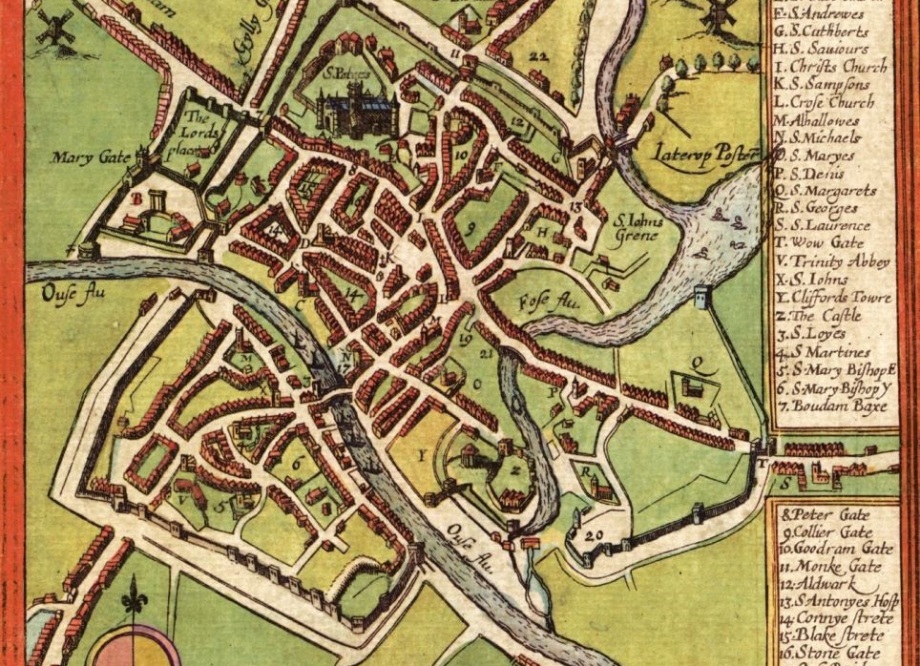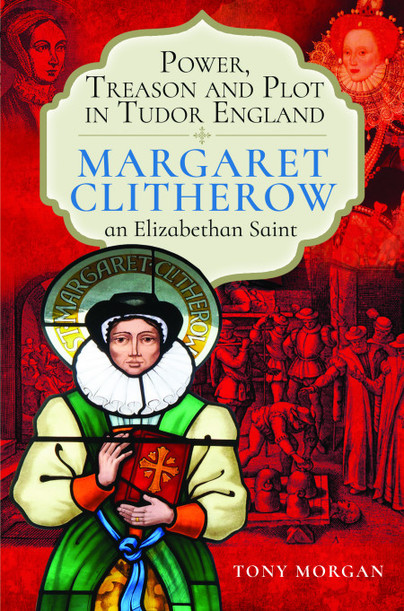The Tudor period was an important, if traumatic, time for the city of York. As so many people are fascinated by the Tudor era, I thought it might be useful to share a few things from my research into Tudor York, focusing on some fairly accessible sources, including a few of my favourites.
This is the second of a series of three blogs.
- The first blog explored resources for researching the wider national and religious tensions of the Tudor period, particularly during the reign of Elizabeth I.
- This one examines researching the impact these issues had on the city of York and the grand and not so grand people who lived there.
- The third blog will focus on the history behind the life and death of Margaret Clitherow.
My interest in Tudor York stems from writing about two of the city’s most famous, or perhaps infamous, citizens who lived during the reign of Elizabeth I – Guy Fawkes and, as mentioned above, Margaret Clitherow.
Like others researching and writing about Tudor York, I owe a large debt of gratitude to two historians in particular – D. M. Palliser and J. C. H. Aveling. Their previous in-depth and investigative research about this period included getting to the bottom of the civil, social and religious aspects of life in York. If you’re interested into getting under the covers of what really went on, I’d recommend D.M. Palliser’s “Tudor York” as a great starting point.
That book gave me a good understanding and feel for the set up and office holders of the Corporation of York. These men, for there were only men, were the merchants and other well to do trade guild representatives who ran the administration of the city, which since 1396 had been independent of the wider county and Ridings. Today, we’d probably think of them as upper middle class.
More than that, it helped me to understand how, particularly in the first half of Elizabeth I’s reign, Corporation of York officials were often in conflict with the Council of the North, the crown’s major legal and administrative body for the northern counties. During Elizabeth’s reign, the Council moved from being a roving body visiting four locations to being permanently located at the King’s Manor in York. The conflict was due to the fact that some Corporation councillors, aldermen and lord mayors retained Catholic sympathies. This didn’t go down well with the Queen’s representatives, or the Protestant Archbishops of York and other senior clergy.
If, like me, you may be interested in understanding more about the impact of the era’s constantly changing religious laws on the city’s institutions and people, I’d recommend looking for Palliser’s “The Reformation in York 1534-1553” and, in particular, J.C.H. Aveling’s “Catholic Recusancy in York – 1558-1791”. This second book contains painstakingly researched details of the remaining court records, which provide details of who faced the courts and were fined and imprisoned for refusing to go to church or attending an illegal Catholic mass. Of course, Margaret Clitherow and her friends feature many times.
I was lucky to find reasonably priced second-hand copies of the above three books and all three have been invaluable for my own research and writing. For those seeking a more easily available and accessible book, there’s the “History of York – from Earliest Times to the Year 2000” edited by Patrick Nuttgens. This has a very good Tudor York section written by Claire Cross. You might also be able to find “A History of the County of York: the City of York” edited by P.M. Tillott, of which there’s a browsable version online.
Of course, there are many other resources. One of my personal favourites, I could only find online in a scanned PDF format. Titled “The Antiquities of York City, and the Civil Government Thereof” it includes chronological lists of York’s mayors, sheriffs and other dignitaries between the time of Edward I and the “present year” of 1719.
Reading through the many pages, every now and then you come across a gem. For example, the details in 1564 of the post-snowstorm thaw flooding and damage to Ouse Bridge, or the plethora of leading Corporation of York officials who (with no outbreak of plague or other sickness in sight) died or were removed from office between 1580 and 1581. There’s a future story in that one, I’m sure.
There are of course, many other sources. I’ve been lucky in my own research (despite the pandemic) to be helped by some great people in local libraries and universities and at special places, such as the York Minster Library Collections team. I’d love to know something about your own favourite resources and tips for researching Tudor history.
By now, you might be wondering why I was doing this research? As well as writing three historical novels (including The Pearl of York), I’ve just had my first non-fiction history book published. If you like researching Tudor history, you might like it just for the biography!
Power, Treason and Plot in Tudor England looks at national power and religious struggles, the impact they had on the city of York and the life and death of Margaret Clitherow. The book is available from the publisher Pen and Sword’s website, Amazon and at many good book shops.
If you found this article interesting, please return soon, as I’ll be posting the follow-on blog about researching the life and death of Margaret Clitherow.


I will follow this with interest
LikeLiked by 1 person